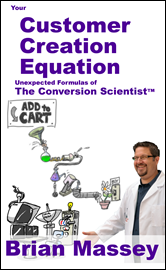While we love to stay in the incredibly measureable realm of the online world, we know that many websites need to fuel action in the real world. As I’m putting the finishing touches on my new book, I am faced with the design that will make my book easy to recognize, easy to describe, and easy to buy.
In the book business, there are two conversions: convert an searcher into a finder, and convert a finder into a buyer.
We’ve already named the book Your Customer Creation Equation: Unexpected Formulas of The Conversion Scientist. Now it’s all about presentation.
My preference will be a white cover with hand-drawn elements and a picture of me. Here is a crude mockup The drawn images are just for placement, and I’ll want to work with my cover designer before doing any drawings.

What do you think? Please let me know in the comments.
There are are some guiding principles I used to come to this collection of elements, many of which you will find in the book when discussing website development.
Here are my guidelines and some examples.
Show the Product
Tim Ash shows a sales funnel on the cover of his book.


In the case of my book, I am the product, as teacher and co-creator of my readers’ digital conversion labs, so it might make sense to put me on the cover.


I don’t find many examples of this in the business book space, and this gives me some pause. However, given the personas I’ve written the book for, it may be a way to look unique in the space.
Encourage word of mouth
When a reader is recommending a book to another person, it is helpful to give them a way to describe the book.
“You really should read the conversion sciences book. I forgot the guys name, but it’s the one with the _________ on the cover.”
In the case of my mockup, they could say “…a guy in a doctor’s coat.” Of course that could sell a lot of books for Bill Nye, the science guy.


The book Presentation Zen might be “one with stacked rocks on the cover.”


Brian Solis book Engage is the “chain” book.


Express Your Brand
Scott Stratten is a funny, self-effacing, contrarian writer and presenter. He says on his Twitter profile that he’s “kind of a big deal on a fairly irrelevant soc media site which inflates my self-importance.”
His book, Unmarketing, is in a plain brown rapper, and looks like it was stamped instead of printed.


This is potentially one of the most powerful integrations of book and marketing, and can make your book instantly recognizable for your most engaged potential readers.
My brand centers around two memes.
Meme 1: The Lab Coat
I wear a lab coat in my presentation and photos. This will be recognized by many of my readers.



Meme 2: Hand-drawn infographs
I occasionally do hand-drawn infographs when at conferences. My book has some of these hand-drawn images in it.

I envisioned an entire lab in hand-drawn fashion, but haven’t had the time to complete it.
Emphasize the author or the topic?
After six years of writing and speaking as The Conversion Scientist, my business brand is much stronger than the book brand. One could argue that it makes sense to highlight my name more so than the book title.
However, I’m not established as an author, and I’m not a household name. People are more likely to be searching for the book title than to be searching for a book by Brian Massey, or the Conversion Scientist.
I could go either way on this one.
Use universal visual memes
Drawing from universal memes in the imagery quickly communicates what the book is (or could be) about. Philip Graves uses the universal sign for shopping, the shopping cart, over and over again in his book cover.


Universal memes for a book by a “Conversion Scientist” include the lab coat, the ubiquitous test tube, the Erlenmeyer Flask, the Bunsen Burner, and other remnants of High School chemistry class.


The chemical equation will either strike fear or recognition in the minds of potential readers.

I have a whole universe of conversion “elements.”

This is probably too over-the-top.
Own a Color
Groundswell owns lime green.


The “For Dummies” series owns yellow and black.


The Guerilla Marketing books own camouflage.


Avoid business porn
In all cases, I want to avoid what I call “business porn,” or the use of happy, beautiful people who inevitably are devoid of emotion and authenticity. Wiley has built an entire series with cover designs like this. The books are excellent. The covers are uninspiring.




The words should be readable
So easily forgotten in the design of covers is that the title and author should be readable. This means
- Avoid placing title and author on a busy background.


- Avoid placing dark text on a dark background. Gradients are especially bad as some part of the text won’t show up no matter which background you choose.


- Avoid placing light text on a light background


- Acknowledge that for aging readers, light text on a dark background is harder to read


- Don’t create font-confusion


Appeal to your readers’ tastes
Once you’ve identified these logical ground rules for your book cover, you can apply your readers’ preferences. This involves choosing designs from other successful books have done in your space.
If you get rid of the business porn, I like the simple design and white background of the Wiley Hour a Day series, and those readers interested in my book have bought lots of books in this series.


I like the had-drawn style of several recent books, and I have some ability to draw a cover such as this.








Stay tuned for the final cover art
I’ll be publishing in less than 30 days, so you can see my final cover.
I’ll notify you wen the book is out if you become a friend of the author. You’ll also get a free video to help you determine your unique site formula to increase conversions.
Talk to me. Comment below.
 We’ve been talking about who you need on your web team. One person was story teller. Another is a draftsman. Draftsmen are designers who are all about function, not just looks. Not that an ugly webpage is good for conversion. Not at all. If a website is ugly, looks amateurish or dated, or is tricky to navigate, it will hurt conversion rather than help it.
We’ve been talking about who you need on your web team. One person was story teller. Another is a draftsman. Draftsmen are designers who are all about function, not just looks. Not that an ugly webpage is good for conversion. Not at all. If a website is ugly, looks amateurish or dated, or is tricky to navigate, it will hurt conversion rather than help it.





























